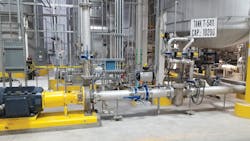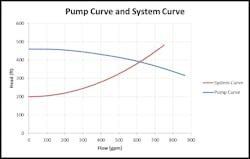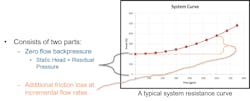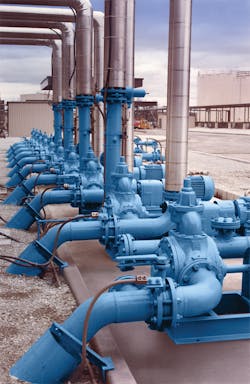Pump system analysis: Tanks, piping, hoses and everything in between
Context is a useful tool for problem solving and decision making. Many of the decisions we make in life are arrived at only after we review a series of reference points. For instance, anyone would consider a $50 loaf of bread to be unrealistically expensive, because a lifetime of bread buying lets you know that it should cost much less.
The same principle applies when attempting to analyze the performance of your pumping system in an industrial/manufacturing application that requires a liquid-handling function. When assessing the performance of your pumps and diagnosing any performance-related issues that may arise, having reference points with which to compare current performance can be an invaluable tool. In other words, you can take that acquired knowledge and use it to empower you to make good, educated decisions regarding the makeup and operation of your pumping system, knowing that one that is completely optimized will result in a streamlined, cost-effective, durable and safe system that will provide many years of reliable service.
This article takes a closer look at some basic indicators that govern the operation of a pumping system, and how you can gain context that empowers you to know how to achieve peak performance under any operating conditions.
Reading pump performance curves
To the uninitiated, a pump performance curve can look like nothing more than a series of random lines of varying colors that don’t have much of a connection to reality. In truth, performance curves — once you have attained necessary context — are a lot easier to understand than you may initially think, and they can be reliable allies when determining the limits of a pump’s operational capabilities.
The first thing to keep in mind is that all pumps, no matter the operating principle, are “simple” machines, meaning that they don’t have a mind of their own but instead will always operate at the intersection of the pump’s performance curve and system’s resistance curve. So, because pumps operate so predictably, knowing as little as two performance curve data points provides a lot of powerful information for the operator.
Introducing system curves
The performance curve is only half of the equation regarding predicted pump performance. The other half is the pump’s system curve. If some operators are put off by performance curves, they can have a really difficult time understanding — or acknowledging the need for — a system curve.
The challenges in understanding a system curve run the gamut from basic to complicated, and can include:
- An impression that it is too complex to ever understand, which can give the operator a feeling that any conclusion is nothing more than a guess.
- Unfamiliarity with the pumping technology, hence no reference points (again, think of that $50 loaf of bread).
- Over the years, pumps and piping may have been added or subtracted from the system.
- Because of the many alterations that may have occurred over time, accurate system diagrams are unavailable.
- The system is 40-plus years old and the original designer is no longer available.
Operators must be able to overcome their initial “fear” of the system curve, knowing that a true understanding of the curve will lead to many benefits for the end user:
- Better preparation to understand any future new installations and upgrades to existing configurations.
- A baseline that can be used to make sanity checks on pump performance simply by comparing input information to known pump and system capabilities.
- An improved ability to choose the best pump technology for the system’s needs.
- Deeper insight into the ways that different configurations or pump technologies can be used to identify a permanent solution to legacy problems, rather than just “kicking the can” down the road with a stopgap solution.
So, where to begin? It is safe to say that if you have inherited a 40-year-old problem it is because 40 years of people have kicked the can to you. Rather than continuing the never-ending process of can-kicking, you can be the hero that solved a decades-old problem by simply diagnosing the problem, finding the root cause and eliminating it.
That process begins by becoming familiar with the system curve, which consists of only two parts: flow and pressure. Every pumping system experiences flow resistance against a set flow rate. So, a system curve is the flow resistance plotted at fixed flow conditions — provided no modulating valves or other transient components are being used. A system curve uses the same two axes as a performance curve: the X axis (horizontal) is always flow rate and the Y axis (vertical) is always pressure.
There are two contributors to every system curve: friction loss and residual pressure. A system curve crosses the Y-axis at the residual pressure and slopes upward according to the friction loss.
Friction loss is a piping system’s resistance to flow. Like increasing air drag on a speeding sports car, pipe friction loss increases as flow velocity increases. From basic fluid dynamics, the Darcy–Weisbach equation shows a very convenient square relationship between velocity and friction loss.
Residual pressure is the system’s zero-flow backpressure. It quantifies the base level system’s resistance at zero flow rate. It consists of two parts: net elevation difference between the source and destination (i.e. static head), and residual pressure difference between the source and destination.
To calculate friction loss, many sources are readily available to pump operator, including the Blackmer Bulletin 33, which tracks friction loss for all pumps and all liquids at viscosities up to 1,000 centipoise (cP). To create a system curve, simply calculate the friction loss at two or more flow rates, add or subtract the zero-flow backpressure and plot those points on the same axis used for the pump curve. Then plot subsequent intermediate points using the simple square Darcy–Weisbach relationship: half the flow, quarter the friction loss.
Measuring friction loss can be an even easier approach. With just two pressure gauges, you can simplify the creation and use of system curves. If you put a gauge at the inlet and discharge ends of the pump, you can use the difference in the two pressure readings to determine the differential pressure or differential head. Since pumps have published characteristic curves, a plant operator can quickly cross reference where the pump operates by checking the measured differential pressure or differential head against the pump curve. In other words, with two gauges, you can throw away your calculator; you won’t need it. You also won’t need a flow meter — just identify which flow rate corresponds to the measured differential head or differential pressure on the pump curve.
Plotting system curves is especially useful for systems that operate in a variety of conditions or those that have a wide operating envelope. Whether its seasonal ambient changes that affect fluid properties or varying tank liquid levels, you will want to know a pump’s performance envelope across a wide variety of applications. Either a measured system curve or a calculated system curve can help you operate your pump efficiently across that range. Simply, plot system curves that correspond to your system’s extremes to see the full range at which your pump will operate.
Rise to shutoff
After operators assess the operating range of a pump and system, it is important to check for problem zones, especially when using centrifugal pumps. Centrifugal pumps have three zones on their performance curves: shutoff, BEP or “Best Efficiency Point,” and runout.
- If a system assessment shows that a pump operates near runout (or the steep portion of curve far from the Y-axis), the motors will have nuisance trips from overload current and pump reliability will decrease from cavitation.
- If a system assessment shows that a pump operates near shutoff (or the flat portion of curve near the Y-axis), the pump and surrounding components will have significant reliability issues, and even destructive water hammer.
Rise to shutoff is defined as the difference between the pump’s operating point and the shutoff pressure. For example, a 3x4-8 pump must deliver 50 gpm and it looks to be OK because on the system curve it is to the right of the “manufacturer’s minimum recommended flow rate” (MRF). But what happens if there is a slight pressure change of approximately one pound per square inch (psi)?
That 1-psi change may appear to be negligible, but a pressure drop of that amount can create a flow-rate flux of as much as 160 gpm in this example. So, a flow rate that can accumulate between zero and 160 gpm can result in dynamic water-hammer pulses through the system, the level of which will be further exasperated if any control devices are being used. The ultimate result will be severe damage to the pump and piping system.
A rule of thumb for hydraulic stability is to maintain at least a 3% rise-to-shutoff factor, though 5% to 7% is more desirable. Anything less than 3% and there will be a fluctuation issue within the process. This takes us back to the claim that pumps are simple; they don’t know where they can best operate because a pressure signal may tell them that they are operating effectively within a wide 160-gpm range.
Inline devices and multiple flow paths
The general introduction of inline devices — such as filters, valves, strainers and heat exchangers — adds complexity to the process of determining pump performance. What if one of those valves is closed or a filter becomes clogged? You can measure friction loss at various stages where a valve is closed, or a filter is clogged and then plot the new performance and system curves. If the range of system curves show that your pump operates in a danger zone, you may then see that the filter needs to be back flushed so the pump can operate in a desirable range. Or it may indicate a need to maintain tank levels to facilitate a smooth, efficient pumping process.
Another system variable is the presence of multiple flow paths in the pumping process. Examples of multiple flow path applications include closed cooling-water systems and burner systems, when one pump feeds multiple users.
In setups like these, the overriding question is: which flow path to use to analyze as pump operation relates to performance and system curves? The simple answer is that it doesn’t matter. Similar to an electrical circuit, the parallel paths in a closed-loop system balance, with any net friction loss experienced in one path the same in all parallel paths. Size the pump for the loop that has the highest back pressure and the balancing valves will simulate equal back pressure for the remaining flow paths.
Conclusion
Increased context can equip you to optimize systems and improve pump reliability. This article described calculation and measurement methods to create systems curves that correspond to a system’s operating envelope. Armed with this context, you can fix legacy problems and make a real difference for your company. Accumulating baseline knowledge and reference points will equip you with the tools to perform checks regarding the operation of your system and help you assess whether it is finding the sweet spot that will result in optimized cost, efficiency, reliability and safety.
Geoff VanLeeuwen, P.E., is the director of product management for Blackmer and PSG. He can be reached at [email protected].



